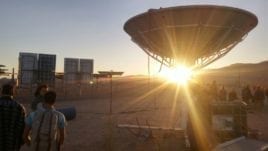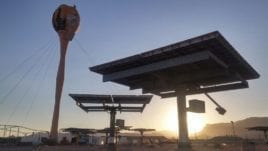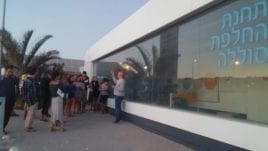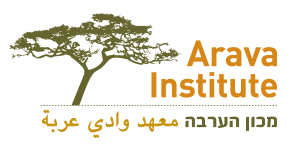
At 3 pm on Monday, our Alternative Energy class set out to explore the sustainable energy practices in some of the nearby Kibbutzim, led by our professor, Dr. Tareq Abu Hamed. After learning about the different alternative energy technologies in the classroom, the group was eager to get out in the field and see them in action.
We started at Kibbutz Elifaz to see their wind turbines and hydroponic farming facilities. The wind turbines were much smaller than the ones we had seen in pictures in class: each blade was only three meters long. We were all surprised when Tareq explained that the typical large industrial turbines could produce two thousand times the energy of the small turbines in front of us. But the smaller turbines have their own advantages, as they can twist and turn with changing wind direction to better harness kinetic energy. Right next to the turbines we could see a row of greenhouses, used for hydroponic farming. This method of farming uses nutrient-enriched water to grow plants without using soil. Lettuce is the main hydroponic crop from Elifaz.

Kibbutz Samar was our next stop. When driving down Highway 90 through the Arava, Samar always stands out because of a strange yellow structure that looms in the desert. As the bus drove closer, students speculated what this could be: was it a leg with an egg on top? Another student was convinced it was some kind of sculpture of a large fruit, and even Tareq said it looked like a flower. But as we got closer, we discovered a large yellow orb mounted in front of several rows of shiny solar panels. The solar tower at Samar was built primarily for studies run by scientists and power companies. However, a fire last year put the tower temporarily out of commission. Having only seen the solar fields at Ketura, it was great to get a close-up look at a different way of harnessing solar energy.

Our last stop on the trip was Kibbutz Yotvata, well known by all of us for their delicious chocolate milk and ice cream. The highlight of the trip was when Tareq walked out of the store with two kilos of ice cream (and vegan sorbet) in his hands and a huge smile on his face. We filled our cups with the best ice cream in the area and followed Tareq to a dusty building, not much larger than a cargo container, with a big window in one side. The building was constructed by a company called Better Place, whose goal was to improve infrastructure for electric cars. As we peered through the one big window, we saw what looked like a car wash, but without any of the cleaning equipment. Electric car owners would be able to drive their car through this building and get a new battery in under four minutes. It’s an enticing idea, especially for us environmental science students. However, Better Place was not able to sell enough electric cars and soon went bankrupt, which explained the unfinished state of the building in front of us.
As we walked back through the parking lot to the bus, Tareq pointed out that the large structures used to shade the cars also had solar panels on top. The class marveled at the simple brilliance of using structures that were already in place to generate sustainable energy, and we can only hope that the rest of the world follows this example.
Submitted by Lila Glansberg

